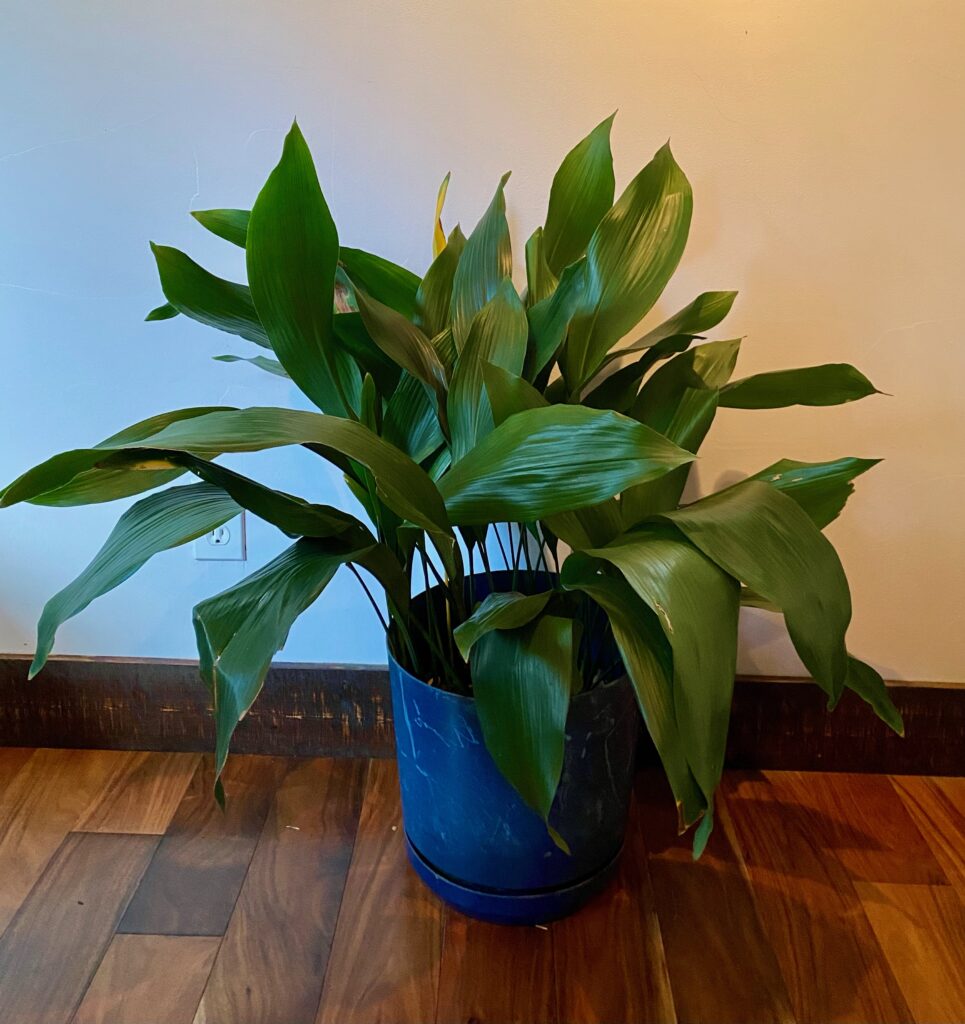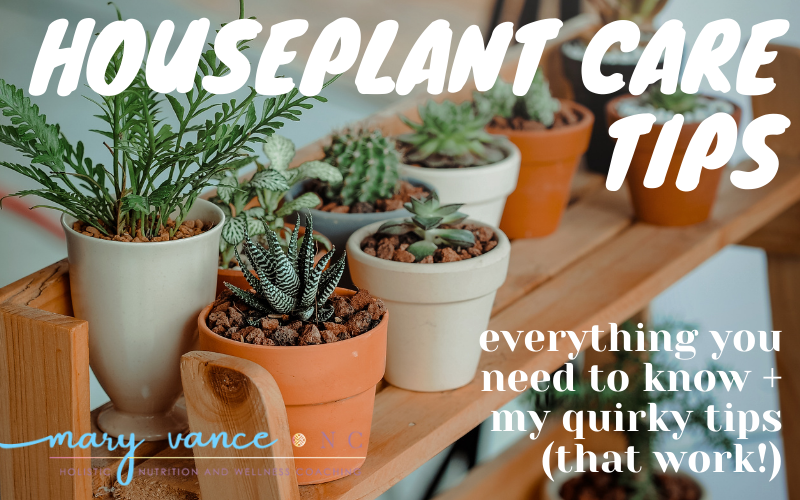Whether you are a newbie houseplant parent, or you have already cultivated a lush indoor jungle, you’ve probably at one point or another googled to get some information or answers to questions about how to best support your houseplants. You’ll probably find a lot of overlap between lists with plant care tips, and you want some fresh, new info! I’ve been fussing and obsessing over my indoor plants for the better part of 20 years now, so I have a thing or two to share about how to care for houseplants, Better yet, I have houseplant care tips you won’t find elsewhere.
Houseplants bring a little of the outdoors inside and immediately brighten and transform your space. They help clean your indoor air and are a joy to grow. Plus, you can toil over them as part of your morning ritual.
My houseplant care tips are perfect for you if you are a novice looking to up your plant game. I’ll discuss the basics like care and feeding and how to help your plants thrive, and I’ll throw in my quirky tips you won’t find elsewhere (you mean you don’t shower with your plants?!). This is the plant care information you’ve been looking for. I’ll give you the best insider tips you need to know to keep your beauties thriving.
Houseplant Care Tips
First off and perhaps most important: Get the right plants for your lifestyle. It can be tempting to grab that pretty plant that catches your eye, but you need to know what kind of plant it is and what conditions it requires. If you’re gone a lot, for example, you’ll need low maintenance plants that don’t require regular watering, like succulents, but maidenhair ferns that are fussy and need a lot of attention may not be a great choice.
My favorite houseplants are pothos varieties, perfect for beginners: They grow so quickly, are very easy keepers, will grow in both bright and low light conditions, and look super lush. They make your indoor space green and bright, and you can drape and arrange the long vines. They’re also easy to propagate and grow in both water and soil. Other easy keepers are snake plants (sansevieria), cast iron plant (aspidistra), draceana, spider plants, monstera, succulents, and ZZ plants.

The cast iron plant (Aspidistra) has earned its reputation as a nearly indestructible houseplant with beautiful foliage. It can survive lots of neglect and growing conditions that will kill many other plants. You often see them in dark, smoky bars. Mine, pictured here, sits in a fairly dimly lit room and thrives.
You’ll often hear certain plants “thrive on neglect,” but this little mantra bugs me. No plant thrives on neglect, but some certainly prefer less fuss or do fine if placed in a low lit area. In fact my cast iron plant really pouts if I water it too much. But plants always thrive when you best adhere to their needs, and that’s usually not neglect.
Lighting for Plants
To grow plants successfully indoors, one of the most important factors to consider is placement. You’ll need to know what type of light the plant prefers in order to decide where to place it in your home. You’ll see that most indoor plants prefer “bright, indirect light.” You’ll also see “filtered light” or “tolerates low light.” The term low light is very misleading. When you’re googling, or the tag on your plant says ‘low light,” it does not mean that these plants need low light. It means that these are plants that tolerate low light.
Low light means no light is hitting your plant’s leaves. It may be away from a light source or in a dimly lit room. Plants make food from sunlight on their leaves, so plants in low light make less food from the sun. They may live, but they won’t thrive and will grow way more slowly. And keep in mind that even low light tolerant plants need some light. They won’t survive in a completely dark room or one that rarely gets any light.
So: consider the light in your house. If you want that new plant that caught your eye, whip out your phone and do a quick google search to make sure it’s right for your living space and your lifestyle. If you already have plants but aren’t sure what they are, start googling so you can learn about them and properly meet their needs. (I’ve literally googled ‘plant with tendrils’ to discover I had a peperomia rosso).
Bright light is usually a south-facing window, and east-facing windows are bright but indirect light. Most areas in your home, except for south-facing windows, receive indirect light. It means the sun isn’t directly hitting your plant’s leaves for a long period of time, which is good because the sun can burn houseplants’ leaves. So open up your compass app on your phone and check which windows face what direction when deciding where to place your plant buddies. I have most of my plants clustered in east-facing windows.

houseplants clustered in east facing windows: pothos, dracaena, monstera, arrowhead plant, wandering jew
Houseplants Like Humidity
Houseplants are often transported to you from the warm, cuddly, humid womb of the greenhouse. Many houseplants like Peace lilies & Monsteras come from jungle type environments and will thrive in humidity. And most homes are fairly dry, especially in the winter with the heat on. Your home should be around 30-40% humidity to prevent mold, but most indoor plants prefer 40-60% humidity (some prefer it more humid).
Increasing humidity levels in the home is easy enough. Misting plants, growing them in groups, running a humidifier, and using water-filled pebble trays under the plant are the most popular methods for raising humidity. (source). Clustering plants in groups allows them to create their own little humid microclimate. Plus, you can place a humidifier in the center of the cluster and run it during the day, or just place a dish of winter in the cluster. If you don’t want to get that fancy, misting them daily is fine too (you’ll see the misting bottle in my picture above).
If you have enough light in your bathroom, consider hanging plants that like humidity around or in your shower. It’s a beautiful addition to a bathroom. They’ll love the extra humidity produced when you take a hot shower. My own bathroom is dark, but I sometimes take my tropical plants in the shower with me so they get some steam and humidity, as I live in a very dry climate.
Again, make sure you look up your plant’s needs because some, like African Violets, don’t like to be misted.
Watering
Now that you’ve gotten to know your plant a bit and figured out where it belongs, you’ll need to determine how to feed and water it. Believe it or not, by far the most common mistake plant owners make is OVERWATERING plants. A good rule of thumb for most indoor plants is to water when the top 1-2 inches of soil is dry (use your finger to test the soil). Some, like succulents, need to completely dry out and some need to be pretty consistently moist. But most plants do not like to sit in soggy soil, and that can cause root rot. Typically during the summer indoor plants need to be watered once per week (some 2-3 times per week) and less during the winter, but it depends on how dry your house is.
If a plant is overwatered, it will wilt and likely develop yellow or brown limp leaves as opposed to dry, crispy leaves, a sign of too little water. It’ll wilt because the roots can’t absorb more water. Overwatered plants look vaguely sickly. One way to prevent overwatering is to make sure the pot you have your plant in has adequate drainage. This usually means it has a hole or holes in the bottom and you have it sitting in a dish. Or if not, just take it over to the sink to water it so water doesn’t leak everywhere. If your pot doesn’t have a hole in the bottom, place a bunch of small rocks in the bottom of the pot before you put the soil and the plant in the pot to create some drainage inside the pot.
Another tip is to water your plant slowly. Most people (and I speak from experience here when I’ve asked people to water my plants) don’t know how much water a plant needs during watering. It depends on the plant and the size, but you never want to see water that hasn’t been absorbed sitting in the pot on top of the soil. Add water slowly and wait for it to soak into the soil. When it starts coming out the bottom of the pot, that’s usually enough. Or if no drainage holes, water fairly thoroughly and make sure soil is saturated but not soggy. Use tepid, not freezing, water.
Letting your soil dry out before watering is key for (most but not all!) plants to receive the the perfect balance of water and oxygen.
You can set a schedule, but plants may not need water on the same day every week. Make a habit to check the soil every few days to see if your plant needs a drink. I make this part of my morning routine. Leafy varieties, like pothos, need water more frequently than succulents and cacti, which need to dry out more thoroughly between waterings. Some plants, like snake plants, actually like to get a bit parched. I water my snake plant every three weeks.
In general, I water most of my plants weekly. The pothos, arrowhead, monstera, spider plants, and draceana average once a week. The cast iron plant (named appropriately because it is hearty and will survive almost any environment), cacti, and snake plant every 2-3 weeks. And I have some fussy varieties like a polka dot plant and a maidenhair fern that need light watering every 2-3 days and daily misting. Eventually you’ll get an intuitive knack for when your plants need water.
Houseplant Feeding
You do need to feed your houseplants or they won’t grow as well and reach their full potential. Fertilizer is basically like a multivitamin for your plants. I feed my plants once a month during active growing season, spring & summer, and once every 2 months while they’re resting during the winter and colder months. Again, there are caveats here for more “advanced” plants and flowering plants, like Christmas cactus and jasmine, when you’re trying to get them to bloom appropriately.
You can get a granulated or liquid fertilizer. You’ll find many complicated feeding regimes online, and you can certainly get as fancy as you want with compost and coffee grounds, but most houseplants will be fine with a basic indoor plant fertilizer. These fertilizers will contain a mixture of both macro- and micronutrients. The three primary macronutrients they need are nitrogen, phosphorous, and potassium, and you’ll often see secondary minerals and even soil-based microbes (bacteria species). You’ll see organic liquid houseplant fertilizers made from liquid kelp, fish emulsion (stinks, do not recommend indoors), compost, worm castings, bat guano, liquid bone meal, rock phosphate, plant extracts, and humic acids.
I’ve used and like Foxfarm organic fertilizers, like this one for indoor plants. Others are formulated for flowering or blooming plants like some succulents or cacti. I like this Happy Frog blend too and it can be used for indoor and outdoor plants. Dr Earth is another good brand. Try this all purpose fertilizer. I also like their bud & bloom booster blend for outdoor flowering plants. No bigs if you can’t find these specific brands, but I like them because they’re organic and provide an array of nutrients. But basically any fertilizer labeled for houseplants should suffice. Just try and get one that has multiple nutrients.
Remember: Houseplants are not in a state of active growth during the winter and therefore should not be fertilized unless you live in a tropical climate where it’s warm all the time. Then keep your houseplants on a summer fertilization schedule year-round.
My Quirky Houseplant Care Tips
As promised, what follows are the unusual houseplant tips you won’t read elsewhere. Sometimes a little finessing can make the difference between a houseplant that’s alive and one that thrives. We’ve covered the basics: getting to know your plant babes, placement, humidity, water & feeding. But here are some off the beaten path tips to help out your plant friends.
First off, potting soil: It hasn’t come up yet, but when transplanting your plants to a bigger or different container, you’ll need potting soil. I use a basic organic all purpose blend for houseplants (like this one), but here’s a tip for you: If you have succulents, they prefer soil that drains better than the usual houseplant blend. So mix in some sand if you don’t have succulent-specific soil. The recipe is 1/2 potting soil and 1/2 sand. If you want to get really fancy you can mix in a small amount of perlite. I usually steal some sand from the beach, but don’t tell anyone.
Next up: get in the habit of watering your plants in the morning, which is the best time of the day for them. Wake up, make a cup of coffee or tea, and go visit your plants. Check the soil to see if they need watering. Look them over to see if they have brown spots, wilted leaves, or signs of pests. This can all give you clues about the care they need. Are they getting too much or not enough sun? Plus, it’s just calming and relaxing.
Also– dust the leaves! Your plants use light to make food, and dusty leaves affects the light they absorb. Carefully clean the leaves with a damp cloth if they look dusty. Then spritz the ones that need misting.

A pothos that needs dusting, sitting in my window. Too much dust prevents them from absorbing light properly.
Use a chopstick to poke holes GENTLY in the top of the soil to create aeration. Don’t jab or poke wantonly, or you’ll damage the roots. You want to oxygenate the soil a bit.
Trim off any dead or darkening leaves. Don’t worry about it; leaves die! Give the leaf a little tug. If it releases easily, it’s ready to come off. If not, leave it for a bit, as the plant may still be getting nutrients from it.

Yellowing leaf that needs to be trimmed off the cast iron plant. No big deal; sometimes leaves die! If it happens regularly though it could indicate too much or too little watering.
You can, of course, shower with the plants that like humidity. I drag some of my plants into the shower so they’ll enjoy the steaminess and humid conditions. They love it. And remember when finding places for your plant pals to cluster them in groups so they create humidity.
When you’ve finished your tea, if you have any left, give it to your plants! (provided It’s cool). They love green tea and herbal teas that are rich in minerals. You can also use coffee grounds (nitrogen rich) or epsom salts for extra minerals, but be sure to google if they’re appropriate for your plant.
Finally, if you’re just getting into the world of houseplants (or you just need a reminder), when you bring a new plant home, it needs time to acclimate. It may drop some leaves or go through an adjustment period. Same after repotting. And you will probably kill a plant or two along the way. It happens. But if you have info on your plant’s needs, plus these tips and a little intuition, you’re set to be an A+ plant parent.
Pin it!

Mary Vance is a Certified Nutrition Consultant and author specializing in digestive health. She combines a science-based approach with natural therapies to rebalance the body. In addition to her 1:1 coaching, she offers courses to help you heal your gut and improve your health. Mary lives in San Francisco and Lake Tahoe in Northern California. Read more about her coaching practice here and her background here.








